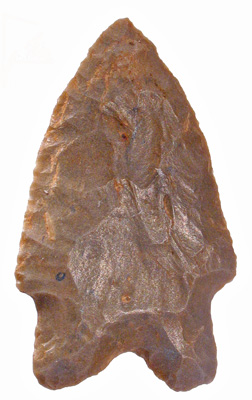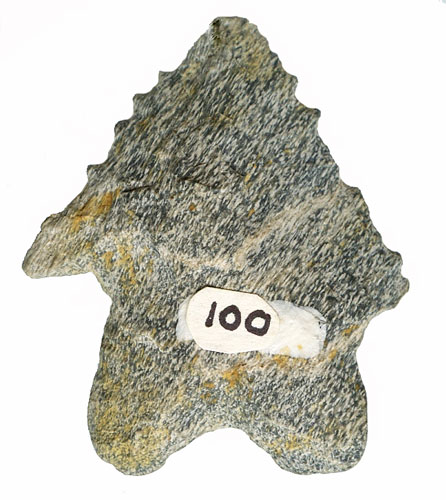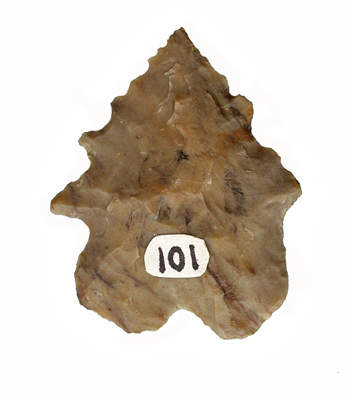





Point Type: LECROY
Also See: Big Sandy Auriculate,
Cossatot, Decatur, Fox Valley, Hi-Lo, Jakie Stemmed, Jerger, Jude, Kanawha, Kirk-Bifurcated, Lake Erie,
MacCorkle, Montell, Pine Tree,
Rice Lobbed, St. Albans, Southampton, Uvalde
Location: Eastern United States
Associated Dates:
9000 - 5000 B.P. - Early Archaic to Mid Archaic
Morphology: Bifurcated
General Description: The LeCroy type is a small to medium sized, thin, usually broad bladed, point, with deeply notched or serrated blade edges and a deeply bifurcated base. Basal ears can either be downward angling or expanded out. The stem is usually large in comparison to the blade size. The blade is relatively broad, triangular, and thin with either straight or slightly excurvate edges. The distal tip can be mocronate and the proximal portion has small, slightly expanded, horizontal, sometimes struck barbs. Some stem sides are fractured in Northern examples (Lake Erie). The basal edges are usually ground.
LeCroy points are found along the Tennessee River and its tributaries in Northern Alabama and Tennessee. They have been found along the Cumberland River in Porter County, northwestern Indiana, Albemarle County in Virginia and near Roseville, Michigan. The type is fairly widespread in the eastern United States.
The LeCroy point can range in size from 19 mm to 42 mm in length, 15 mm to 28 mm wide and 4 mm to 6 mm in thickness. The type was named by Madeline Kneberg in 1956 for examples which she recovered from the LeCroy site on the Tennessee River in Hamilton County, Tennessee.
About The Point Above (Left): The LeCroy point pictured at the top of this page on the left is an average sized LeCroy point made from a red jasper material. The point measures 38 mm in length, 24 mm wide across the shoulders and is only 6 mm at its thickest point near the shoulders. The base tapers down to 3 mm in thickness and is ground. The blade edges are straight and have no serrations. The basal concavity is 4.4 mm deep and the stem is 10.5 mm long and 20 mm wide. This point was found near the town of Mount Herman, Warren County, New Jersey. Catalog Number 110-19-C
About The Point Above (Center): The LeCroy point pictured at the top center of this page is a very large LeCroy point made from a mottled gray and black rhyolite with inclusions of rust colored iron oxide flecks. The point measures 40 mm in length, 34 mm wide across the barbs and is 6.5 mm at its thickest point near the shoulders. The base tapers down to 4 mm in thickness and is ground. The blade edges are straight and have serrations. The basal concavity is 4.5 mm deep and the stem is 16 mm long and 24 mm wide. Overall the point is quite impressive considering the lithic material used in manufacture, which is quite uniquely attractive and undoubtedly accounts for the large size for this specimen. This point was found along the beach shore of Maryland. Catalog Number 100-75-R
About The Point Above (Right): The small LeCroy point pictured at the top right hand side of this is a very large LeCroy point made from red jasper with dark brown streaks. The point measures 30 mm in length, 24 mm wide across the barbs and is 4.9 mm at its thickest point near the shoulders. The base tapers down to 1.0 mm in thickness and is lightly ground. The blade edges are straight and have serrations. The basal concavity is 2.8 mm deep and the stem is 14 mm long and 18.5 mm wide. This point was found on the shore of the Housatonic River, Milford, Connecticut at the former Baldwin Station site. Catalog Number 100-75-R
References: Baker, Bell (2), Hranicky, Justice, Overstreet, Perino (1), Puckett (1, 2), Waldorf, Ritchie
© Copyright 1997 - 2009 LITHICS-Net WWW.LITHICSNET.COM
Use your Browser's BACK Button to return to the LITHICS-Net Index.